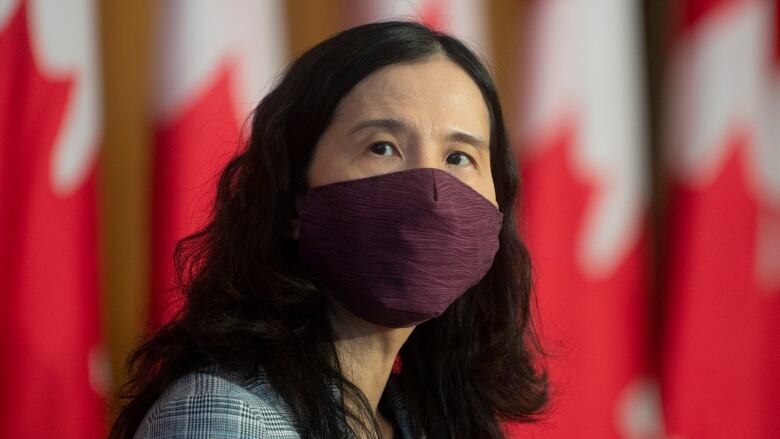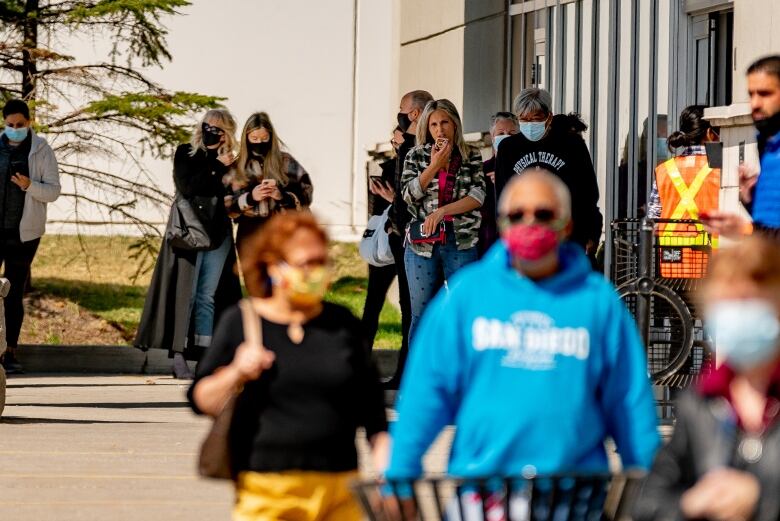Federal modelling data suggest lockdowns have slowed COVID-19 spread
Dr. Theresa Tam says restrictive public health measures should be maintained until summer

The stringent public health measures implemented in some provinces have slowed the rapid spread of COVID-19, according to new modelling data from the Public Health Agency of Canada.
Top health officials are now urging provinces to maintain those restrictive policies until the summer to keep the pandemic at a manageable level.
While recent weeks have seena troubling spike in the number of deaths and hospitalizations asCOVID-19 variants wreak havoc, province-wide restrictions andlockdowns in B.C., Ontario and Quebec are already showing results.
Case countsare slowly levelling off in most provincesbut the data suggestthe number of new infections is still climbing in Alberta and Manitoba.
The national "rT" themetric that tracks the average number of peopleone infected person will pass the virus on to has dipped below 1. Dr. Theresa Tam, Canada's chief public health officer, called that"a spark of good news."
If the provinces can keep the rT below one, then the number of new cases will continue to decline, she said.
"For the first time in many weeks, the epidemic has dropped out of a growth pattern," Tam said. "We have reassurance that strengthened measures can slow growth where more contagious variants are circulating, but sustained measures and individual practices arethe key tokeeping growth down."
While the federal modelling suggests there will be a slight acceleration in the number of deaths over the next two weeks a consequenceof sky-high caseloads in some provinces this month short-term forecasts predict there will be a slower increase in the number of cases between now and May 2.
The number of deaths is expected to rise from the 23,822 reported Thursday to a high of 24,570 by May 2.
The number of new cases will be "brought under control,"said Dr. Howard Njoo, the deputy chief public health officer, if the public continues to adhere tolockdown rules for the foreseeable future.
WATCH:When can Canadians expect their second AstraZeneca dose?
Keep the lid onuntil summer: Tam
"There's reason to be hopeful. We are starting to see provinces and territories implement public health measures and there are positive results. We can see the rates of infection are going down," Njoo said in French.
The modelling suggests that, without these measures, daily case counts would rise to at least 15,000 a day nationwide. If people continue to stay home as much as possible and reduce their social interactions,the number of new daily cases could fall below 5,000 by mid-May.
Tam said the mostrestrictive measures could be gradually liftedaftermore adults have had at least one shot of a COVID-19 vaccine.
A high vaccine uptake in the coming months with at least 75 per cent of adults getting one dose will help to decide whether it will be safe to lift lockdownsthis summer, she said. The data suggest that at that rate of vaccination, hospitalizations would be kept to a moreacceptable level.
"These models give us hope, illustrating that there is a safe way to lift most restrictive public health measures, like certain workplace and business closures, by this summer, if enough people get vaccinated," Tamsaid, urging all Canadians to get the first shot they're offered.
She said that once 20 per cent of the adult population is fully vaccinated with two doses of a COVID-19 shot,officials can start to easethe most stringent measures.
At that point when 75 per cent of Canadians have had one shotand 20 per cent have had both "if you're careful, you won't get a resurgence," she said. But if fewer than 55 per cent of adults get a shot,there's a chance hospitalizations couldspike again in the fall.

Pointing to the U.K. where governmentofficialshave maintained lockdowns even as theirvaccine rollouthasaccelerated Tam said experience shows "strong and sustained measures" are needed to suppress rapid growth of the more contagious variants until vaccines have been deployed widely.
Conservative MPs Michelle Rempel Garner andPierre Paul-Hus, the party's critics for health and procurement, issued a statement blaming the federal government's vaccine procurement effort forthe third wave.
"We need the government to succeed in their efforts to get vaccines to Canadians," the statement said."However, their failure to secure vaccines in January and February and their failure to secure the border to prevent the spread of variants have cost Canadians their lives and livelihoods."
Rempel Garner and Paul-Hus also said recently announced delays in the delivery of vaccine doses from Moderna and the Serum Insinuate of India are "not good news" as cases continue to increase andlockdowns continue in many parts of the country.
Federalgovernment orders booster shots from Pfizer
Prime Minister Justin Trudeau said todaythat while it's been "a very tough spring," with caseloads doubling over the last month and hospitalizations on the rise, there's "good news" on the vaccine front.
With 30 per centof all Canadians having had at least one shot already, another 2 million doses including the first batch of the Johnson & Johnson product will arrive next week, he said.
"The situation is critical, but we can and we will beat back this third wave. What we have to do is clear. We need to stay home and avoid in-person contacts," Trudeau said.
To keep a possible COVID-19 resurgence at bay in the years to come, Trudeau said the government has signed a contract to procure 35 million booster doses from Pfizernext year and 30 million more the year after, with options for up to 30 million additional doses.
As healthofficials eye a 75 per cent vaccination rate by summer, Trudeau and his wife,Sophie Grgoire Trudeau, each received the AstraZeneca shot at an Ottawa pharmacyto bolster confidence invaccine safety.
WATCH: Trudeau receives the AstraZeneca vaccine
While the vaccine issafe and effective, ithas been the subject of much debate in recent weeks withcompetingrecommendationsabout who should get the vaccineand when.Some provinces including Ontario, where the prime minister lives dropped AstraZeneca-related age restrictions this week to allow anyone 40 and over to get a dose.
The modelling data suggestCOVID-19 vaccines havehad their desired effect alreadyinolder age cohorts. The number of COVID-19 cases among people over 80 has dropped dramatically from 35 cases per 100,000 in January to less than 5 now.
In Indigenous communities, where vaccines have been more plentiful, the number of active cases has dropped from 5,000 in mid-December to fewer than 1,000.















_(720p).jpg)


 OFFICIAL HD MUSIC VIDEO.jpg)
.jpg)



























































































